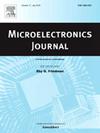Workload variation compensation optimization of ring oscillator temperature measurement method and its application in field-programmable gate array
IF 1.9
3区 工程技术
Q3 ENGINEERING, ELECTRICAL & ELECTRONIC
引用次数: 0
Abstract
—With the ongoing improvements in semiconductor manufacturing technology, the supply voltage required for field-programmable gate array (FPGA) chips is gradually decreasing. As a result, the oscillation frequencies of ring oscillators are affected more obviously by voltage fluctuations, and the sharp changes in the oscillation frequency that can be caused by small changes in the FPGA core voltage have become a problem that cannot be ignored for digital temperature sensors. In this paper, we use a 28 nm FPGA chip to realize a digital temperature sensor network, and at the same time deploy 32 temperature sensors for comprehensive temperature monitoring of the FPGA chip; the monitoring process mainly characterizes the non-ideal influence of the workload changes on the ring oscillator's response. The temperature measurement method, which is based on the oscillation frequency, is modified to compensate for the influence of core voltage variations due to changes in the working load on the output frequency of the ring oscillator. The test results are compared with those from an infrared thermal imager. These results prove that the proposed compensation method can improve the temperature measurement accuracy and ensure that it reflects the actual chip temperature accurately under various working load conditions. This condition is essential for electronic device health monitoring, thermal management, and fault diagnosis scenarios to prevent problems being caused by overheating and to ensure reliable system operation.
求助全文
约1分钟内获得全文
求助全文
来源期刊

Microelectronics Journal
工程技术-工程:电子与电气
CiteScore
4.00
自引率
27.30%
发文量
222
审稿时长
43 days
期刊介绍:
Published since 1969, the Microelectronics Journal is an international forum for the dissemination of research and applications of microelectronic systems, circuits, and emerging technologies. Papers published in the Microelectronics Journal have undergone peer review to ensure originality, relevance, and timeliness. The journal thus provides a worldwide, regular, and comprehensive update on microelectronic circuits and systems.
The Microelectronics Journal invites papers describing significant research and applications in all of the areas listed below. Comprehensive review/survey papers covering recent developments will also be considered. The Microelectronics Journal covers circuits and systems. This topic includes but is not limited to: Analog, digital, mixed, and RF circuits and related design methodologies; Logic, architectural, and system level synthesis; Testing, design for testability, built-in self-test; Area, power, and thermal analysis and design; Mixed-domain simulation and design; Embedded systems; Non-von Neumann computing and related technologies and circuits; Design and test of high complexity systems integration; SoC, NoC, SIP, and NIP design and test; 3-D integration design and analysis; Emerging device technologies and circuits, such as FinFETs, SETs, spintronics, SFQ, MTJ, etc.
Application aspects such as signal and image processing including circuits for cryptography, sensors, and actuators including sensor networks, reliability and quality issues, and economic models are also welcome.
 求助内容:
求助内容: 应助结果提醒方式:
应助结果提醒方式:


